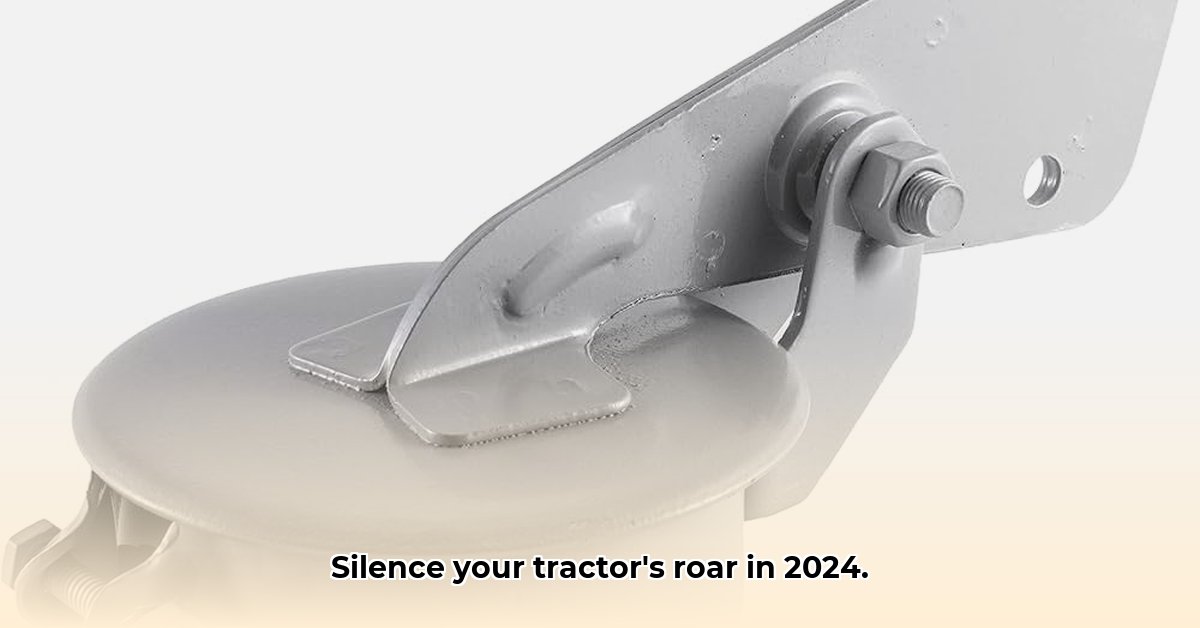
Muffler Tractor Supply: Finding the Perfect Exhaust System for Your Needs
Choosing the right tractor muffler can feel daunting, but this guide simplifies the process, helping you select the ideal muffler from Tractor Supply or similar retailers. We'll cover selection, installation, and maintenance, ensuring you get the quietest, most efficient exhaust system for your farm. For more muffler options, check out this helpful resource: Tractor Muffler Guide.
Understanding Your Tractor's Exhaust Needs: A Crucial First Step
Before purchasing, assess your tractor's specific requirements. Just like choosing shoes, the right muffler depends on your needs.
- Identify Your Tractor: Note the make, model, and size (often found on a plate attached to the tractor). This information ensures proper fit and optimal performance.
- Budgeting: Tractor mufflers vary widely in price. Determine a realistic budget to avoid surprises.
- Noise Levels: Consider the acceptable noise level. Some mufflers prioritize quiet operation, others durability. Noise regulations in your area might necessitate a quieter model.
- Safety Considerations: If you operate in dry brush or fire-prone areas, a spark arrestor muffler is a crucial safety feature, preventing fire hazards.
Exploring Muffler Options at Tractor Supply and Beyond: A Comparative Analysis
Tractor Supply offers various mufflers for different tractors and budgets. Key types include:
| Muffler Type | Advantages | Disadvantages | Ideal Use Cases |
|---|---|---|---|
| Standard Replacement | Affordable, readily available, easy install | May not significantly reduce noise levels | Basic replacements on a budget. |
| Heavy-Duty | Durable, withstands harsh conditions | More expensive upfront | Frequent use in demanding environments. |
| Spark Arrestor | Prevents sparks, crucial for fire safety | Typically more expensive | Essential for fire-prone areas. |
| Low-Noise Mufflers | Substantially reduces engine noise | Usually higher-priced | Areas with noise restrictions or for increased comfort. |
Remember, individual models may vary. Always check manufacturer specifications. Isn't it important to understand your needs before investing?
Step-by-Step Guide to Choosing and Installing Your Tractor Muffler: A Practical Approach
Selecting the right muffler is only the first step. Proper installation is crucial for safety and optimal performance.
Identify Your Tractor: Record the make, model, and engine size for accurate muffler selection.
Consult the Manual: Your owner's manual specifies the correct muffler size and type, preventing compatibility issues.
Visit Tractor Supply (or similar retailer): Compare mufflers in person, referencing the above table. Don't hesitate to ask questions!
Careful Comparison: Consider lifespan, noise reduction, and additional features. A longer-lasting muffler may be a better long-term investment.
Compatibility Verification: Double-check the muffler's specifications against your tractor's requirements before purchase.
Professional Installation (Optional): If you lack mechanical experience, professional installation is recommended to prevent damage and voiding warranties.
DIY Installation (If Skilled): If installing yourself, follow manufacturer instructions meticulously. Use appropriate safety gear (gloves, eye protection). Never work on a hot exhaust system.
Keeping Your Tractor's Muffler in Top Shape: Essential Maintenance
Regular maintenance extends muffler lifespan and improves tractor performance.
Regular Inspections: Regularly inspect for rust, dents, or loose connections. Address issues promptly.
Cleaning: Depending on operating conditions, periodic cleaning might be necessary to prevent excessive buildup. Refer to your owner's manual.
A well-maintained muffler ensures smooth tractor operation, a quieter work environment, and a safer working experience. This investment safeguards the long-term health and efficiency of your tractor.
How to Overcome Financial Barriers to Precision Farming Adoption for Small-Scale Farmers
Precision farming offers immense potential for increased yields and profits for small-scale farmers. However, the high cost of technology can be a significant obstacle. How can this be overcome?
Assessing Your Needs and Budget: A Strategic Approach
Before investing in technology, identify your farm's biggest challenges (e.g., irrigation, soil nutrient levels). Prioritize technologies addressing these needs. This allows for more efficient resource allocation and maximizing return on investment. Create a realistic budget including equipment, software, training, and maintenance costs.
Exploring Funding Options: Securing the Necessary Resources
Several options exist to finance precision farming upgrades.
- Government Grants and Subsidies: Many governments offer financial assistance for sustainable agriculture practices, including precision farming. Research local and national programs using relevant keywords online.
- Loans and Financing: Agricultural banks and credit unions offer specialized farm improvement loans. A strong business plan highlighting ROI is essential for loan approval.
- Partnerships and Cooperatives: Joining forces with other farmers increases buying power, leading to lower equipment and service costs.
- Leasing and Rental: Leasing or renting equipment spreads costs and allows testing before committing to a purchase.
- Crowdfunding: A crowdfunding campaign can be a viable option for innovative projects.
Prioritizing Technology Choices: A Smart Investment Strategy
Focus on cost-effective solutions with a proven track record.
- Low-cost Sensors: Soil moisture sensors provide valuable data at a relatively affordable price, optimizing water management and increasing yields.
- Used Equipment: Consider purchasing pre-owned equipment in good condition to significantly reduce costs.
- Open-Source Software: Explore free or open-source software for data analysis and farm management.
Maximizing Return on Investment: Ensuring Long-Term Success
Proper training is crucial for effective technology use. Accurate data collection and analysis are vital for informed decision-making. Regular maintenance prevents costly repairs. Continuous monitoring of yields, costs, and resource use is essential for assessing and improving ROI.
Key Takeaways:
- Incremental Adoption: Start with affordable, high-impact technologies.
- Funding Exploration: Investigate grants, loans, and partnerships.
- Prioritization: Focus on technologies addressing your most pressing challenges.
- Continuous Learning: Invest in training and monitor results for optimization.
- Collaboration: Network with other farmers to leverage resources and knowledge.